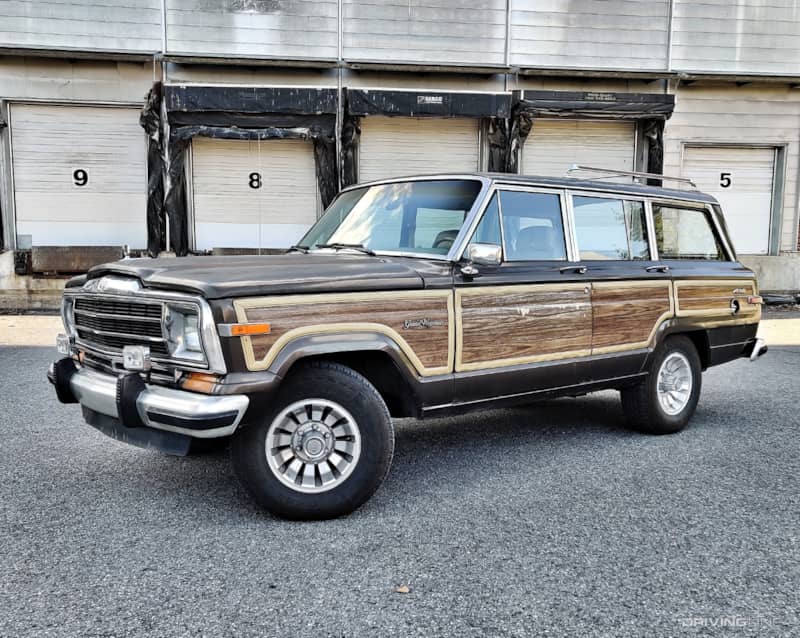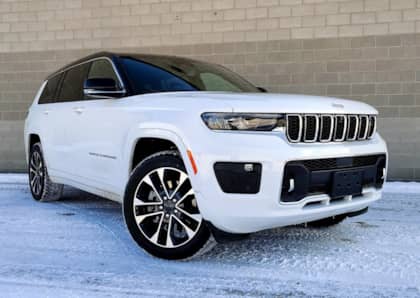Tow Tested: The 2022 Jeep Grand Wagoneer SUV Is A Luxurious And Thirsty Trailer Rig
I've been driving my 1978 Datsun 280Z track car to various road courses around New England for the past five years, and I've finally had enough. Although I love the car, it's an oven in the summer heat that fumigates the cabin with exhaust as soon as I roll down the windows, leaving me with the choice of boiling alive or slowly asphyxiating to death.

Throw in the fact that there's almost no separation between the cockpit and the car's loud, droning exhaust, and that the Datsun's '70s-era tin provides zero protection in the event of a collision with any one of the thousands of enormous SUVs I regularly encounter during the 500-mile roundtrip slogs, and it's fair to say that the experience is more than a little taxing—especially driving home after a full day spent sliding around a race track.

And so, I decided to do myself a kindness and build a tow rig: my LS-swapped, 1987 Jeep Grand Wagoneer. Unfortunately, due to the timing on installing the truck's air conditioning system (the latest in a series of modernizations designed to make it comfortable and safe while lugging a trailer down the road), my Jeep wouldn't be available for the first event of the season.

It's a good thing I had an alternative at hand. The 2022 Jeep Grand Wagoneer might not share much in common with my own Grand Wagoneer other than the name, but it certainly proved itself a comfortable, if thirsty, stand-in while towing my Datsun up and down New Hampshire's White Mountains.
Sky's The (Towing) Limit
Although I had previously driven the all-new Jeep Grand Wagoneer at the time of its launch, my experience with the vehicle didn't include putting its prodigious tow rating to the test. Built on a modified version of the Ram 1500 pickup platform, the 2022 model features a max trailer rating of 9,850 lbs. That's a hefty figure, one that is made possible not just by the Jeep's body-on-frame construction, but also its standard 6.4L V8 (472 hp, 455 lb-ft of torque), its adjustable air suspension system, and its available towing package (which includes heavy-duty cooling, tow hooks, a trailer hitch assist feature for its backup camera, and a trailer brake controller).

My particular towing needs don't come close to touching the Grand Wagoneer's upper limits. With a curb weight of roughly 2,500 pounds, my Datsun soaks up less than a quarter of the Jeep's tow spec, and even combined with a U-Haul trailer the combined load is barely over the 5,000 pound mark. Throw in another 200 lbs or so of track day gear, and the Grand Wagoneer was unlikely to break a sweat regardless of how much climbing it had to do between my Montreal, Quebec starting point and my Loudon, New Hampshire destination.
Angles And Planks
Hitching up the trailer was remarkably easy, as the Jeep's camera system made it simply to line up the ball with the hitch. Also helpful was the adjustable air suspension, which dropped the ball low enough to fit under the hitch, then popped it up into place at the touch of a button (with the feature making it a cinch to detach the trailer as well).

A more difficult challenge was posed by loading the trailer itself. U-Haul's auto transporters feature an open center section with 3-inch ridges on either side that are designed to keep a vehicle's wheels centered in the event of any bouncing while underway.

While I had successfully towed the Datsun in the past on a flat-bottom trailer, my 280Z's extremely low frame rails—we're talking two finger-widths above the ground—looked to be perfectly positioned to slam into this angled iron.

After consulting with the rental agent, and doing a bit of online research on how other owners of ultra-low vehicles handled U-Haul's constraints, I settled on a strategy of placing 12 feet of 2x8-inch plywood along the wheel channels to lift the vehicle above the problematic ridges. While it was a bit disheartening to see the price of lumber these days ($100 for a trio of boards), it was cheap insurance to make sure I could actually use the trailer I had rented.

The gambit was a successful one. With the assistance of a set of borrowed foam Race Ramps to further soften the angle of the U-Haul's integrated ramps, I was able to load the car without any issue, even clearing the front wheel stop with the lip of the car thanks to the planks.

Due to the enormous proportions of the Grand Wagoneer, I was also able to fold down the rear seats and store all that wood, plus the ramps, behind the first row with room to spare.
Load Master
With Tow/Haul mode selected, the Jeep's eight-speed automatic gearbox did its best to keep the 6.4-liter motor in proper powerband, as well as take advantage of engine braking whenever possible. While it did make a noticeable difference in gear selection as compared to towing in 'Auto' mode, I didn't see any changes to the vehicle's air suspension settings in terms of locking out 'Aero' mode, which is the Jeep's preferred stance at highway speeds.

Another quirk of Tow/Haul was how it interacted with the vehicle's adaptive cruise control system. With cruise set, engine braking seemed to be minimized compared to when I was handling the accelerator myself. It's important to note that the Grand Wagoneer's driving aides, such as lane centering, are not available with a trailer connected. I wasn't able to test out the trailer brake controller, as U-Haul's setup relied on surge brakes rather than electronically controlled stoppers.

As expected, the Jeep Grand Wagoneer barely noticed the extra weight tacked on to its hitch. What I mean by that is despite several substantial climbs through the mountains, the Jeep never struggled to maintain a 65 mph pace. The eight-speed was great at dropping a gear when needed, as smoothly as possible, and despite driving up the revs to tackle the steepest sections of interstate the SUV's cabin remained well-insulated and calm, with only a minimal amount of mechanical noise intruding.

The Grand Wagoneer also provided a stark contrast to my father's tow rig as he accompanied me to New Hampshire. His 2012 Ford F-150 is equipped with a 5.0L V8 rated at 360 hp and 380 lb-ft of twist, and while his pickup weighs about 700 pounds less than the chunky Jeep, his trailer and track car (a 2005 Ford Mustang GT) added another 2,000 pounds or so to his load.

The difference between the two vehicles was most evident when climbing. The Ford was much more comfortable at 70 mph, which allowed it to take a run at some of the larger elevation changes on the highway, whereas the heavier Jeep towing the lighter load was content regardless of speed.

As a result, my father was a little frustrated by my decision to stick to 65 mph, but I was concerned by the condition of the U-Haul equipment (always an unknown), as well as a vibration that came and went in the front-end of the Grand Wagoneer that was potentially linked to the trailer.
Drink Up
Of course there's a price to pay to take advantage of everything the Jeep has to offer. Actually more than one: in addition to its eyebrow-raising window sticker ($113,780 as tested), the Grand Wagoneer's propensity for sucking down premium fuel adds a serious kicker to the cost of towing. I saw 13 miles per gallon during my time tugging my 5,000 pound load, a figure that's roughly 35 percent lower than the Jeep's guzzling 20-mpg highway rating.

That kind of efficiency hit is fairly typical for any vehicle towing that much weight, but it's definitely something to consider given current fuel prices. There are plenty of rides out there that will deliver similar practicality with somewhat better fuel mileage, with diesel options available from GM in all three of its same-sized SUVs. Two of them (the GMC Yukon Denali and the Cadillac Escalade) match the Grand Wagoneer for luxury and features, if not necessarily interior style.

Jeep does have a secret weapon on the horizon in the form of its new 3.0L twin-turbo inline six-cylinder engine, which has just been added as an option for the Grand Wagoneer. With a higher power rating and a more modern design, it's entirely possible that this drivetrain will deliver the same tug with a little bit less juice compared to the current V8 setup.

Either way, there's no question that the Jeep Grand Wagoneer is an exceptionally comfortable highway mile-eater. Featuring a beautiful interior, massaging seats (heated and cooled of course), and a well-tuned independent rear suspension, the Jeep presents a low-drama, high-class companion for anyone who wants to relax after bumping around a race track in a '70s-era sports car.
More From Driving Line
- Does The 2021 Cadillac Escalade Rise Above The Already Excellent GMC Yukon Denali SUV?
- All-New 2021 GMC Yukon Review: Is Smoother Better For GM's Biggest SUV?
- Review: The 2021 Chevrolet Suburban Duramax Diesel Is The Ultimate Full-Size American SUV
- Review: The 2021 Chevrolet Silverado 1500 Duramax Diesel Provides Maximum Torque And Fuel Mileage But Can't Match Refined Rivals











